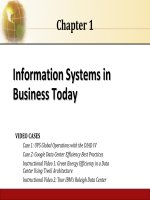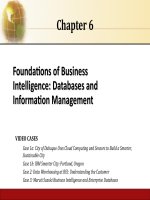Management information systems 13th laudon chapter 01
Bạn đang xem bản rút gọn của tài liệu. Xem và tải ngay bản đầy đủ của tài liệu tại đây (1.11 MB, 42 trang )
Chapter 1
Information Systems in
Business Today
VIDEO CASES
Case 1: UPS Global Operations with the DIAD IV
Case 2: Google Data Center Efficiency Best Practices
Instructional Video 1: Green Energy Efficiency in a Data
Center Using Tivoli Architecture
Instructional Video 2: Tour IBM’s Raleigh Data Center
Management Information Systems
Chapter 1: Information Systems in Global Business Today
Learning Objectives
• Understand the effects of information
systems on business and their relationship to
globalization.
• Explain why information systems are so
essential in business today.
• Define an information system and describe
its management, organization, and
technology components.
1.2
Copyright © 2014 Pearson Education, Inc.
Management Information Systems
Chapter 1: Information Systems in Global Business Today
Learning Objectives (cont.)
• Define complementary assets and explain
how they ensure that information systems
provide genuine value to an organization.
• Describe the different academic disciplines
used to study information systems and
explain how each contributes to our
understanding of them.
• Explain what is meant by a sociotechnical
systems perspective.
1.3
Copyright © 2014 Pearson Education, Inc.
Management Information Systems
Chapter 1: Information Systems in Global Business Today
Shortening Lines at Disney World: Technology to the Rescue
• Problem: Long lines limit how many rides, shops, and restaurants a
customer can visit during a stay.
• Solutions: Enhance customer satisfaction and spending by using
information systems to spot gridlock and improve crowd flow.
• Operational Command Center uses video cameras, digital maps,
computer programs, and mobile apps to monitor attendance,
registers, and spot and prevent gridlock
• Demonstrates IT’s role in increasing value and revenue in any
business.
• Illustrates the potential for technology to improve customer
experience.
1.4
Copyright © 2014 Pearson Education, Inc.
Management Information Systems
Chapter 1: Information Systems in Global Business Today
The Role of Information Systems in Business Today
• How information systems are transforming
business
– Emerging mobile digital platform
– Growing business use of “big data”
– Growth in cloud computing
• Globalization opportunities
– Internet has drastically reduced costs of operating
on global scale
– Increases in foreign trade, outsourcing
– Presents both challenges and opportunities
1.5
Copyright © 2014 Pearson Education, Inc.
Management Information Systems
Chapter 1: Information Systems in Global Business Today
Information Technology Capital Investment
FIGURE 1-1
1.6
Information technology capital investment, defined as hardware, software, and communications equipment,
grew from 32 percent to 52 percent of all invested capital between 1980 and 2009.
Copyright © 2014 Pearson Education, Inc.
Management Information Systems
Chapter 1: Information Systems in Global Business Today
Interactive Session: Management
RUNNING THE BUSINESS FROM THE PALM OF YOUR HAND
Read the Interactive Session and discuss the following questions
• What kinds of applications are described in the case? What
business functions do they support? How do they improve
operational efficiency and decision making?
• Identify the problems that businesses in this case study
solved by using mobile digital devices.
• What kinds of businesses are most likely to benefit from
equipping their employees with mobile devices?
• Discuss the implications of this statement: “The iPhone is
not a game changer, it’s an industry changer.”
1.7
Copyright © 2014 Pearson Education, Inc.
Management Information Systems
Chapter 1: Information Systems in Global Business Today
The Role of Information Systems in Business Today
• In the emerging, fully digital firm:
– Significant business relationships are digitally
enabled and mediated.
– Core business processes are accomplished through
digital networks.
– Key corporate assets are managed digitally.
• Digital firms offer greater flexibility in
organization and management.
– Time shifting, space shifting
1.8
Copyright © 2014 Pearson Education, Inc.
Management Information Systems
Chapter 1: Information Systems in Global Business Today
The Role of Information Systems in Business Today
• Growing interdependence between ability to use
information technology and ability to implement
corporate strategies and achieve corporate goals
• Business firms invest heavily in information systems
to achieve six strategic business objectives:
1.9
1.
Operational excellence
2.
New products, services, and business models
3.
Customer and supplier intimacy
4.
Improved decision making
5.
Competitive advantage
6.
Survival
Copyright © 2014 Pearson Education, Inc.
Management Information Systems
Chapter 1: Information Systems in Global Business Today
The Interdependence Between Organizations and Information Technology
Figure 1.2
1.10
In contemporary systems there is a growing interdependence between a firm’s information systems and its
business capabilities. Changes in strategy, rules, and business processes increasingly require changes in
hardware, software, databases, and telecommunications. Often, what the organization would like to do depends
on what its systems will permit it to do.
Copyright © 2014 Pearson Education, Inc.
Management Information Systems
Chapter 1: Information Systems in Global Business Today
The Role of Information Systems in Business Today
• Operational excellence:
– Improvement of efficiency to attain higher
profitability
– Information systems, technology an important
tool in achieving greater efficiency and
productivity
– Walmart’s Retail Link system links suppliers to
stores for superior replenishment system
1.11
Copyright © 2014 Pearson Education, Inc.
Management Information Systems
Chapter 1: Information Systems in Global Business Today
The Role of Information Systems in Business Today
• New products, services, and business models:
– Business model: describes how company
produces, delivers, and sells product or service to
create wealth
– Information systems and technology a major
enabling tool for new products, services,
business models
• Examples: Apple’s iPad, Google’s Android OS,
and Netflix
1.12
Copyright © 2014 Pearson Education, Inc.
Management Information Systems
Chapter 1: Information Systems in Global Business Today
The Role of Information Systems in Business Today
• Customer and supplier intimacy:
– Serving customers well leads to customers returning,
which raises revenues and profits.
• Example: High-end hotels that use computers to track
customer preferences and used to monitor and
customize environment
– Intimacy with suppliers allows them to provide vital
inputs, which lowers costs.
• Example: JCPenney’s information system which links
sales records to contract manufacturer
1.13
13
Copyright © 2014 Pearson Education, Inc.
Management Information Systems
Chapter 1: Information Systems in Global Business Today
The Role of Information Systems in Business Today
• Improved decision making
– Without accurate information:
• Managers must use forecasts, best guesses, luck
• Results in:
– Overproduction, underproduction
– Misallocation of resources
– Poor response times
• Poor outcomes raise costs, lose customers
– Example: Verizon’s Web-based digital dashboard to
provide managers with real-time data on customer
complaints, network performance, line outages, and
so on
1.14
Copyright © 2014 Pearson Education, Inc.
Management Information Systems
Chapter 1: Information Systems in Global Business Today
The Role of Information Systems in Business Today
• Competitive advantage
– Delivering better performance
– Charging less for superior products
– Responding to customers and suppliers in
real time
– Examples: Apple, Walmart, UPS
1.15
Copyright © 2014 Pearson Education, Inc.
Management Information Systems
Chapter 1: Information Systems in Global Business Today
The Role of Information Systems in Business Today
• Survival
– Information technologies as necessity of business
– Industry-level changes
• Example: Citibank’s introduction of ATMs
– Governmental regulations requiring recordkeeping
• Examples: Toxic Substances Control Act,
Sarbanes-Oxley Act
1.16
Copyright © 2014 Pearson Education, Inc.
Management Information Systems
Chapter 1: Information Systems in Global Business Today
Perspectives on Information Systems
• Information system:
– Set of interrelated components
– Collect, process, store, and distribute
information
– Support decision making, coordination, and
control
• Information vs. data
– Data are streams of raw facts.
– Information is data shaped into meaningful form.
1.17
Copyright © 2014 Pearson Education, Inc.
Management Information Systems
Chapter 1: Information Systems in Global Business Today
Data and Information
Figure 1.3
1.18
Raw data from a supermarket checkout counter can be processed and organized to produce meaningful
information, such as the total unit sales of dish detergent or the total sales revenue from dish detergent for a
specific store or sales territory.
Copyright © 2014 Pearson Education, Inc.
Management Information Systems
Chapter 1: Information Systems in Global Business Today
Perspectives on Information Systems
• Three activities of information systems
produce information organizations need
– Input: Captures raw data from organization or
external environment
– Processing: Converts raw data into meaningful
form
– Output: Transfers processed information to
people or activities that use it
1.19
Copyright © 2014 Pearson Education, Inc.
Management Information Systems
Chapter 1: Information Systems in Global Business Today
Perspectives on Information Systems
• Feedback:
– Output is returned to appropriate members of
organization to help evaluate or correct input stage.
• Computer/Computer program vs.
information system
– Computers and software are technical foundation
and tools, similar to the material and tools used to
build a house.
1.20
Copyright © 2014 Pearson Education, Inc.
Management Information Systems
Chapter 1: Information Systems in Global Business Today
Functions of an Information System
An information system
contains information about an
organization and its
surrounding environment.
Three basic activities—input,
processing, and output—
produce the information
organizations need. Feedback is
output returned to appropriate
people or activities in the
organization to evaluate and
refine the input. Environmental
actors, such as customers,
suppliers, competitors,
stockholders, and regulatory
agencies, interact with the
organization and its
information systems.
Figure 1.4
1.21
Copyright © 2014 Pearson Education, Inc.
Management Information Systems
Chapter 1: Information Systems in Global Business Today
Information Systems Are More Than Computers
Using information systems
effectively requires an
understanding of the
organization, management, and
information technology shaping
the systems. An information
system creates value for the
firm as an organizational and
management solution to
challenges posed by the
environment.
Figure 1.5
1.22
Copyright © 2014 Pearson Education, Inc.
Management Information Systems
Chapter 1: Information Systems in Global Business Today
Perspectives on Information Systems
• Organizational dimension of information
systems
– Hierarchy of authority, responsibility
• Senior management
• Middle management
• Operational management
• Knowledge workers
• Data workers
• Production or service workers
1.23
Copyright © 2014 Pearson Education, Inc.
Management Information Systems
Chapter 1: Information Systems in Global Business Today
Levels in a Firm
Business organizations are
hierarchies consisting of three
principal levels: senior
management, middle
management, and operational
management. Information
systems serve each of these
levels. Scientists and
knowledge workers often work
with middle management.
Figure 1.6
1.24
Copyright © 2014 Pearson Education, Inc.
Management Information Systems
Chapter 1: Information Systems in Global Business Today
Perspectives on Information Systems
• Organizational dimension of information
systems (cont.)
– Separation of business functions
• Sales and marketing
• Human resources
• Finance and accounting
• Manufacturing and production
– Unique business processes
– Unique business culture
– Organizational politics
1.25
Copyright © 2014 Pearson Education, Inc.









